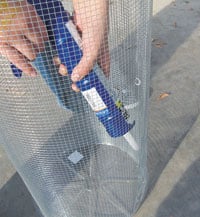Building your own chameleon lizard cage is often a satisfying experience.
Building your own enclosure is often satisfying for a handy person. In the many years that I have kept reptiles and amphibians, I often built my own enclosures.
Chameleons present special challenges in what materials you can safely use and how you design the enclosure. In this article, I will discuss the various considerations you will face housing chameleons and detail some inexpensive caging solutions for them.
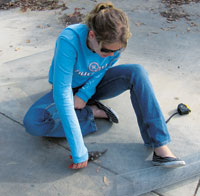
If you have a roll of hardware cloth to cut, sitting or using a weight on the unrolled portion works well while you're cutting and measuring.
Caging Considerations
Chameleons in particular are very sensitive creatures; they are sometimes considered delicate or even impossible to sustain for a long period of time. As co-owner of Sticky Tongue Farms, I have been told many times that I can’t do the exact thing that I have done for years, which is to successfully house, breed and hatch several species of chameleons over many generations. Still, whether you plan to keep one animal or hundreds in a greenhouse, certain rules must be followed.
Try to duplicate the animal’s natural habitat as much as possible. For instance, if you live in the desert (like I do) and have desert chameleons such as Chamaeleo oustaleti or C. verrucosus, they might like the heat and enjoy basking in 110 degrees. However, when they have had enough, a fully shaded area with a bush and a mister is necessary. On the other hand, in such heat species from Cameroon (e.g., C. montium or C. quadricornis) could potentially drop dead before they find the shade.
Education is as crucial as observation for chameleon keepers. Some chameleons, no matter how perfect the enclosure is, simply won’t tolerate being enclosed.
Sometimes misinformed pet store employees or show vendors encourage hobbyists to purchase aquariums for their chameleons. I implore you to reconsider this habitat choice.
In the past, it was thought that chameleons had a problem with the airflow in aquariums. Through years of observation, it is now agreed that the reflection, not the lack of airflow, is the real culprit. The chameleon perceives the other chameleon (its reflection) as a constant threat. Without the ability to escape the aggressor, the animal’s stress level is so elevated that the immune system starts to break down, inviting illness. I’ve only been able to successfully use an aquarium with small leaf chameleons like Brookesia peramata or B. superciliaris. With all other chameleon species, I discourage aquarium use.
If you can’t afford to spend money on the proper environment, don’t purchase the animal. The biggest expense is often the enclosure, not the animal itself. Easy-to-assemble or preassembled cages that are fine for chameleons are available at reptile shows, or through reptile magazines and the Internet.
And, of course, you can always build your own.
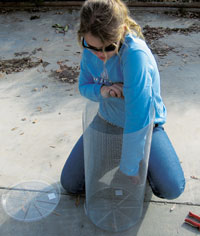
Roll the cut hardware cloth into a tube and place one end into one of the plastic water saucers to measure for a snug fit.
Sizes and Placement
Most people are looking for easy, inexpensive housing and settle for an enclosure that is too small for their chameleon. Size is always important. A minimum of 2 feet square by 2 feet tall per subadult to adult chameleon is recommended. If space is an issue, remember that height is always more important than width for these arboreal species. Putting a cage on a table or hanging it can also make a chameleon more comfortable. The enclosure should be large enough for the chameleon to exercise. Any and all rough, exposed edges must be covered with wood, silicone or plastic tubing to prevent injury.
If the chameleon paces and claws at the enclosure all day, it may need a different environment. Simply moving the enclosure to a different part of the house may be all that is needed. Stress is the enemy and should be reduced at all cost. Housing chameleons separately and out of view of each other is crucial for their health and well being. Don’t assume that chameleons on opposite sides of a room are separated sufficiently, especially if they’re still in plain view of each other. Long-term harassment, even from a distance, will cause a chameleon to stop eating, get respiratory problems or die unexpectedly.
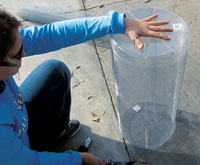
The water saucers will be used on both ends of the tube to shape the cage.
How to Build a Tube Cage for Chameleons
I use tube cages, with their inexpensive and quick design, exclusively due to the ease of cleaning and mobility. To construct a tube cage, you will need the following, all of which is available at your local hardware store:
- A 4-foot wide, 57-inch-long piece of quarter-inch hardware cloth. This comes in a plastic-coated variety that is better for a chameleon’s sensitive feet. A piece this size will be enough for one 17-inch-diameter, 4-foot tall cage. Some stores will cut it for you. If you buy a larger roll, you will need wire cutters to cut a piece the size you need.
- Six hog rings, wire ties or zip ties Hog ring pliers
- Clear silicone caulking
- Caulking gun
- Two plastic plant water saucers measuring 17 inches in diameter.
- Plants
- Sticks
- Small bungee cords
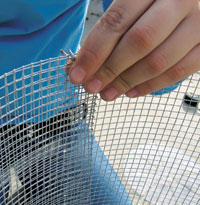
Once rolled to the proper diameter, secure the hardware cloth at the top and bottom using fastners such as hog rings, wire ties or zip ties.
Roll the hardware cloth into a tube so that the tube fits snugly into one of the plant saucers. The two ends of the hardware cloth should overlap about 3 inches. (The diameter of your cage depends on the diameter of the plastic plant saucers that will go on the top and bottom. You can use larger saucers for a larger-diameter cage. Just measure the circumference of the plant saucer you want to use, and add 3 inches so you can overlap the ends of the hardware cloth when forming the tube to fit into the saucers.)
Secure the top and bottom of the tube with a hog ring or zip tie. Fasten the remaining zip ties, hog rings or wire ties along the edge until no gaps appear.
Place one end of the tube inside a plastic dish and secure with silicone. Put a bead of silicone along the hardware cloth seam on the inside of the cage. Be liberal with the silicone all along the edge to cover any sharp edges.
When the silicone dries, the tube cage is surprisingly durable and will take years of abuse. If the silicone becomes loose or the saucer breaks, simply attach a new saucer in the same fashion. The hardware cloth will outlast plastic saucer replacements many times over. Wire can also be fashioned into a handle and secured to the cage to make moving it easier.
Place a nontoxic plant (see the “Plant Paradise” sidebar for tips on choosing a plant) inside, and some perches. A chameleon’s feet are very similar to a bird’s feet. Provide various sized branches and sticks in the enclosure. This encourages proper circulatory function and eases cramping and joint pain. If only one size of branch or perch is provided, foot problems may occur. Fresh, green, smooth branches from the yard or different sizes of dowels are OK. Variety is the key to exercising the feet properly.
Now add your chameleon and put the other water saucer on top. Secure the top saucer with small bungee cords to ensure your chameleon doesn’t escape.
It takes longer to purchase the supplies than actually assembling the tube cage!
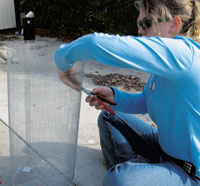
Use additional fasteners to secure the 3-inch "flap" created by the overlapping hardware cloth. Do not leave any gaps.
Lighting Suggestions
If housing your chameleon indoors, place the enclosure in a well-lit area, but don’t put it in direct sunlight coming through a window; this can rapidly bake your chameleon.
There are many brands of reptile-specific lights available; you want a lamp that produces high levels of UVB and UVA.
Chameleons also require a heat source for basking. A combination of fluorescent tube lights and a dome reflector with a heat lamp has worked best for me. Do not allow your chameleon to come into direct contact with any light or heat source, otherwise it could get burned.
A few monitored hours per week outside is better than no natural light at all. If you allow your chameleon to free range in the yard, however, it could escape. Instead, keep your chameleon in a secure cage, such as the tube cage described, while it’s outdoors. Again, be sure there is a shady area to which it can retreat (the plant in the tube cage should be able to provide some shade).
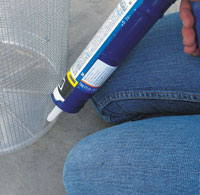
Use silicone caulking to attach the bottom plant saucer to bottom of the cage. Caulk along the circumference of the saucer on both the inside and outside of the cage.
Misty and Humid
Chameleons are tropical animals and need moderately high levels of humidity. During dry seasons, wild chameleons rely on morning dew during dry seasons for hydration. A dehydrated chameleon will drink from standing water, but this is an act of desperation. Plus, chameleons are susceptible to respiratory and eye infections brought on by dehydration.
Watering twice daily via a pump sprayer or automatic mister is my preferred method for hydrating chameleons. When the relative humidity is low, I place a cool mist humidifier by the chameleon enclosures. A weekly soak in the shower for adult chameleons is also advised; lukewarm water on a light mist or spray for an hour is all that is needed.
Some species may even be momentarily startled by a shower. In Hawaii, I have seen them jump out of trees to the ground when it started to rain. When they realize what is happening, they settle down and drink normally.

Run a bead of caulking along the seams of the cage where the hardware cloth overlaps. This helps prevent possible injury to the chameleon as a result of sharp edges.
Feeding Techniques
There are as many different theories about feeding chameleons as there are species. The tongue is a muscle and needs to be exercised or it will atrophy. Hand feeding is great fun, but nothing is better than watching a chameleon hunting for prey and stretching every muscle in its body, hanging precariously, then shooting its tongue two-and-a-half times the length of its body for a clean hit. Allowing your chameleon to “hunt” on occasion is a good idea. A chameleon becomes lazy if it’s only fed from a dish, and the tongue will often shorten permanently.
Loose crickets, however, can turn on chameleons if too many are allowed to roam the enclosure. Prey items have been known to eat on chameleons’ eyes and skin. Make sure your chameleon eats any offered crickets within a short time, and placing cricket food in the enclosure reduces the risk to your chameleon.
A combination of feeding techniques can be used, including by dish, hand and free-range feeding. Not all chameleons eat the way you think they should, so experiment to see what works for yours.
A friend has had luck placing a brick in a plastic tub so the worms and crickets crawl around on it, enticing picky eaters. Others use paper towel tubes with the same success; the crickets crawl over the tube and make better targets by attracting the chameleons’ attention. Be sure no paper towel remnants remain on the tube to be accidentally ingested.
Position the food dish where the chameleon is sure to find it. It is important to have a stick or branch directly over the dish for easy access. Tongue injuries can result if they get stuck to glass bowls or sticks.
Feeding hatchlings to subadults is harder because pinhead crickets are nearly impossible to offer in a dish. Hand feeding at this age is also difficult. Simply place the prey items at the base of the plant, and allow the crickets to crawl through the branches. Again, take care not to put in too many crickets at one time, as they seem to really enjoy feasting on newborn chameleons.
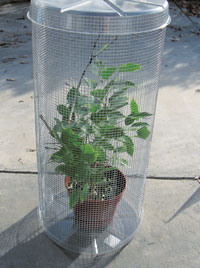
When the caulking has dried, your cage is ready to be furnished with a plant and perches for your chameleon.
Cleaning the Cage
Chameleon enclosures need to be clean for optimal health. Weekly cleaning with the removal of fecal matter, dead insects and leaves is recommended. This reduces the chances of ants and other pests being attracted to the enclosure.
Parasites and bacteria can be a potential problem for keepers as well as chameleons. Maintaining a clean environment and washing your hands reduces the chance of you becoming ill. Use a disinfectant to kill bacteria. Disinfectants, however, are not effective on parasites.
The chameleon should be removed from the enclosure during cleaning, and any cleaning products should be thoroughly rinsed out of the enclosure to prevent any harm to your chameleon.
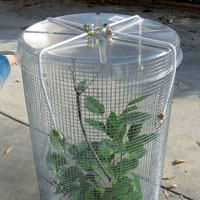
Three types of salamander larvae
Hatchling Housing
I was once caught by surprise when dozens of chameleon eggs hatched simultaneously. Needing to house all these new babies, I improvised by using a 40-gallon trash can, a clip light, a small tree and paper towels for a substrate.
This temporary housing was not only inexpensive, but also effective in keeping the humidity up and stress levels down. My home is busy with dogs, kids and adults, and the trash cans provided a visual barrier that an entire clutch could use for weeks until they were separated into screen enclosures.
To house hatchling to subadult chameleons, attach mesh screening to your tube cage, over the hardware cloth. Hatchlings usually will not eat out of a food dish, and their pinhead crickets need to be contained in the cage. This can be accomplished by fastening mesh around the outside of the tube and then siliconing the bottom plastic saucer in place. The mesh keeps the pinheads in the cage.

Using a pump sprayer twice a day to mist your cage and chameleon reduces the chances of dehydration.
Outdoor Living
Permanent outdoor enclosures need to be constructed to prevent pests from chewing through the enclosure and attacking the chameleon. Plastic-coated hardware cloth seems to withstand the elements better than regular quarter-inch wire.
Ants also pose a threat. Like crickets, ants seem to go for the eyes and can kill a chameleon if not caught in time. Some chameleon keepers place the legs of the table on which the cage sits into cans containing vegetable oil. Ants won’t cross the oil; the ones that do will drown (as long as the oil hasn’t solidified).
Spraying insecticides of any kind around the enclosure is not a good idea. Loose crickets can ingest the poison and in turn be eaten by the chameleon.
Rats are a problem in my neighborhood, and they are brutal to chameleons, often eating tails and limbs. Outdoor enclosures should be constructed of coated wire to keep rats out. They can eat through the window screening that is used in some store-bought chameleon enclosures; these screened enclosures are only recommended for indoor chameleons.
Whether you build or buy your chameleon’s enclosure, try to give your pet a habitat that mimics its natural environment as much as possible. This will ensure that your chameleon thrives.

